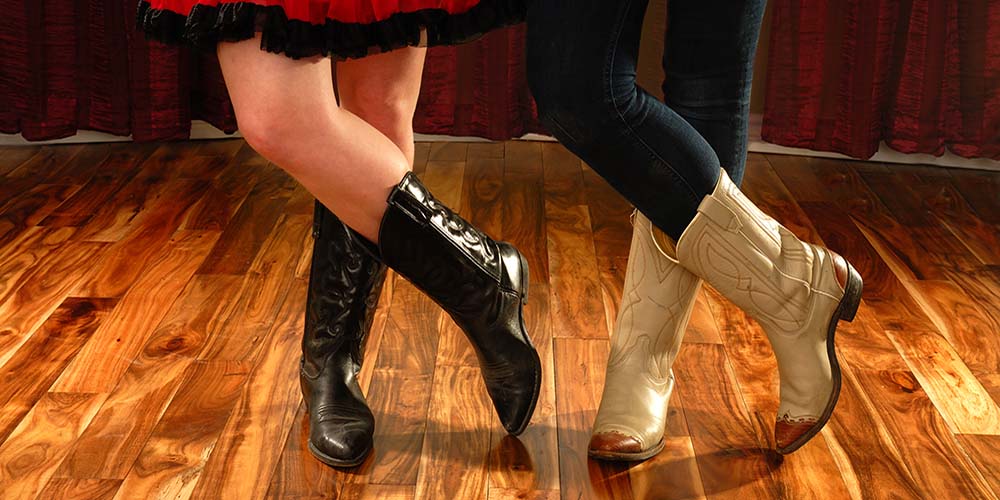The two-step is a dance involving two partners, one leading and one following, moving counter clockwise around the room to the pace of the music. The two-step is most popular with country music but can be danced with any music with a corresponding 2/4 or 4/4 step beat.
Once the music begins, the "leader" begins by stepping forward with the left foot, and the "follower" steps back with their right (both dancers will do the opposite steps of each other). It is danced with two quick steps followed by two slower steps, two more quick steps, then two more slower steps, then repeated. In simpler terms, the two-step is danced quick-quick-slow-slow, quick-quick-slow-slow (QQSS) as you make your way around the room.
It can also be danced quick-quick-slow (QQS) depending on the style of two step you are dancing. The QQS dance method, also known as the Texas Polka, is danced with two quick steps followed by one slow step, but it is the modern QQSS (originally known as the Texas Shuffle Step or Foxtrot Step) that is more widely held this day and age as it allows for several stance variations. The traditional quick-quick-slow-slow pace might change with the music, but the dance steps remain the same. The only alterations come from different holds and stances.
Traditional and Contemporary Holds

The traditional stance has both partners facing each other with space between them, but the more contemporary and popular stance has both partners holding each other closely, or a closed stance. Since both dancers are in close proximity, both leader and follower will shift there stances outward in order to ensure their feet will not collide, basically standing offset of each other. With this stance, the leader and follower will have the hand placement the same as traditional, but the leader will face their hips slightly towards the outstretched hands, and their partner shifting their hips in the opposite direction.
Though the traditional and contemporary stances/holds are most popular, there are several variations which include the Sweetheart, Shadow, Night Club and two-step to name a few. We've listed their intricacies below.
The Texas Two-Step
There are several variations to hold or stance but the Texas two-step is the most traditional. It begins with both leader and follower facing each other, with the leader's right hand on their partner's upper waist or lower shoulder. The leader's left hand is out to the side at a slightly bent angle to hold their partners right hand. Both dancers will begin with their feet shoulder width apart with an open space between them. The "follower" will place their left hand on their partners right shoulder, with their right hand grasping the leader's open hand, also at a slightly bent angle.
Sweetheart Two-Step
The Sweetheart position has both partners facing the same direction, with the leader's right hand on their partner's shoulder, while both dancers left hands are held out to the side at a slightly bent angle grasping hands. In this case, both "leader" and "follower" will begin stepping with the same left foot (whereas the traditional dance has the partners mirroring each other) but as always utilizing the QQSS method while moving about the room.
Shadow Two-Step
The Shadow stance is similar to the Sweetheart, but instead has the leader's right hand on the follower's right hip as opposed to the shoulder. Both the Shadow and contemporary holds are most prevalent in today's dance society as it allows the partners to dance more intimately and more in tune with one another in these closed positions.
Night Club Two-Step
The Night Club two step is a variation with a more relaxed hold and involves the leader rocking back on their left foot, following with the right for one beat, with both partners facing each other. The "leader" then takes a step with the left foot, followed by the right foot, alternating rocking back on the opposite foot for the next beat and so on. It is more easily defined as a 1-2-3-4 step instead of the traditional QQS or QQSS variations and is beneficial because it can blend to almost any music stlye as opposed to Country music.
Slower Music, Double Two-Step
The double two-step (also known as the triple two-step) is commonly danced to music with a slower beat and the two slow steps of the QQSS are replaced by two sets of triple steps. In contrast, the quick steps now become the slower steps. In other words, the double two-step is counted as 1 and 2, 3 and 4, step, step and repeat. Once the music begins, the "leader" will step forward with their left foot, with the "follower" stepping back on the right foot. The stance will be the same as the traditional or contemporary hold.
The two-step versions listed above are just a few of many options, and can be tailor-made for each set of partners depending on their level of expertise. The two-step involves simple but effective moves which can be found in various dances, and once learned, can be used in many more dance styles and to almost any kind of music.
